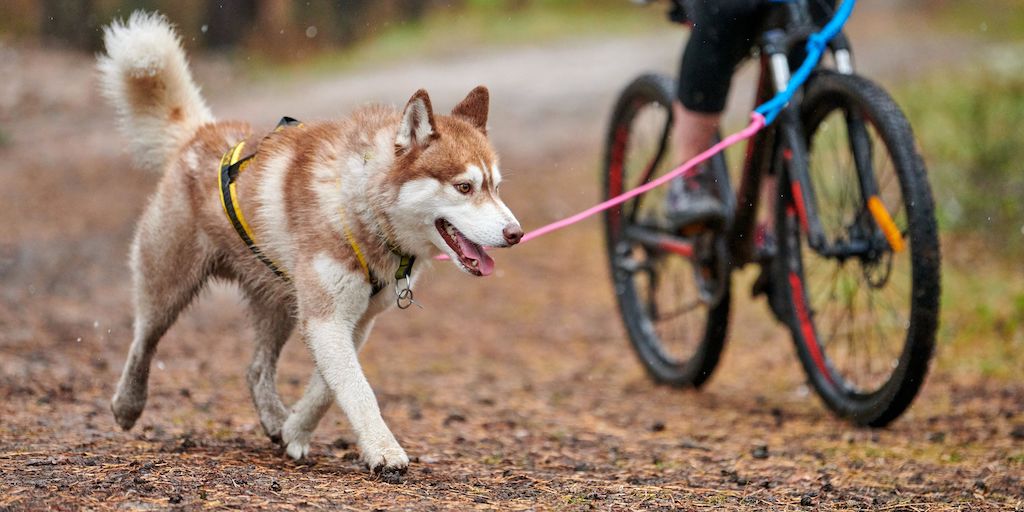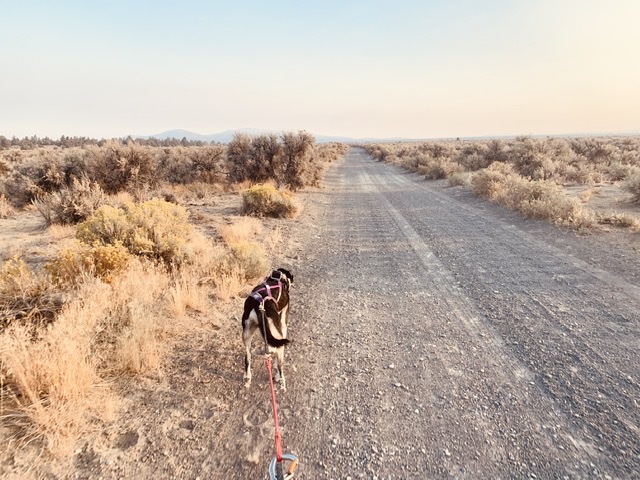
Bikejoring is a simple and fun sport for you to enjoy with your dog in Fall, or year-round if the weather is cool.
Does your dog pull on their leash? How many times have you been frustrated with your pulling dog? Wouldn’t it be nice to just let go and embrace this habit, channeling it toward a mutual goal?
This is where bikejoring comes in.

Bikejoring? What does this strange word even mean?
Bikejoring comes from the concept of, and the word: skijoring. (“Joring”, coming from the Norwegian word “kjoring”, meaning: drive or driving.)
It means that you are “driving” a dog or a pair of dogs from your bicycle, or from cross country skis.
I’ll focus on bikejoring for the sake of this article, as it’s the perfect Fall sport for you and your dog, and it’s more accessible to most people.
What you need to get started
You’ll need a couple of things to get started.
The first piece of equipment you will need is a bike!
I use a lightweight mountain bike, but anything will work as long as you have good brakes. I also recommend purchasing a helmet and knee pads.
The second piece of equipment you will need is an antenna.
YouTube has dozens of videos on how to make your own antenna. However, I purchased mine from Alpine Outfitters, a local company who makes sled dog sport gear.
I bought the bikejoring noodle. It’s a contraption where the leash line that attaches to your dog’s harness is threaded through a noodle-like piece.
The antenna’s purpose is to make sure the leash line stays out ahead of your front wheel and doesn’t get tangled up.
Third, you’ll need a leash line.
This can also be purchased from Alpine Outfitters or a similar dog sport gear supplier.
Sometimes these lines come with a short bungee cord close to the end. This isn’t required but helps absorb a bit of the shock when your dog starts or stops abruptly.
You don’t want the bungee part of the line to be longer than about 6 inches. Otherwise, the pressure will confuse your dog.
Fourth, you’ll need a well-fitting harness.
You likely think of a half-back harness when you think of dog harnesses. The half-back harness comes together and clips about halfway down the dog’s back.
These will work just fine as long as they don’t start rubbing your dog’s armpit skin.
If that starts to happen, it’s smart to consider a running x-back harness. These are padded harnesses that criss-cross along your dog’s back to create the even pressure when your dog is pulling.
And the best part…
Lastly, you’ll need a dog!
Many breeds can be ideal bikejoring dogs.
Your dog should be over 30 points and over 18 months old.
Breeds that are particularly good for bikejoring include:
- Siberian Huskies
- Alaskan Huskies
- Standard Poodles
- Eurohounds
- Pointers
- Rhodesian Ridgebacks
- Labrador Retrievers
- Alaskan Malamutes
- Samoyeds
…the list goes on… but the most important thing is just a willing participant!
Training
Your dog might be a natural, especially if working or pulling is in their blood.
But most dogs will need a little guidance to get going. If you can find a class or a workshop, do that!
But you can certainly train your dog yourself and get equally great results.
The “Line Out” Command
Teaching the Line Out command is possibly the most important thing you can teach your dog about bikejoring.
“Line Out” simply tells your dog to get out in front of the bike, pointing forward and to put a little bit of tension on the leash line.
You can teach this command by putting on your dog’s harness, clipping a leash around your waist, and placing a reward just out of reach for your dog.
When your dog pulls on the leash to get closer to his reward, say: “line out”! Then let him move forward to collect his treat.
YouTube is a great place to get a visual of what this might look like for you and your dog.
Once you’ve mastered line out, try training your dog left/right commands!
It’s all about having FUN
Once you’ve gathered all of your gear, and your dog has some idea of what’s expected of them, you’re ready to hit the trails.
Remember to be patient with yourself and your dog.
You’re both learning something new and skills take time to develop.
Make sure you’re using positive training methods and don’t push too hard too fast.
You want your dog to keep having fun!
Learning to bikejor can be a great bonding experience for you and your dog, and it’s a wonderful way to get some exercise or freshen up your routine.
So have fun out there and be safe!

